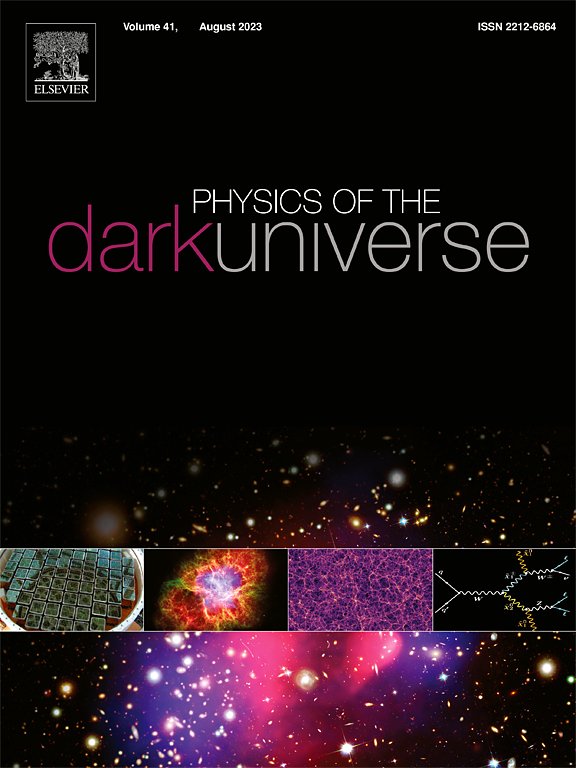分析polyΛCDM动力学
IF 5
2区 物理与天体物理
Q1 ASTRONOMY & ASTROPHYSICS
引用次数: 0
摘要
在本文中,我们研究了ϕCDM和polyΛCDM模型,并将它们与标准的一致性模型(香草ΛCDM)进行了比较。由于所选择的能量密度分量,对于精度至关重要的ϕCDM模型的解析解与ΛCDM的一致性低于%,但与相同方程的数值解的较大差异强调了它们比刚性系统的数值积分的可靠性。polyΛCDM模型是一个修正的现象学重力模型。我们分析了它们各自的时代演变,对每个框架进行了详细的分析和数值动力学分析,并在框架之间进行了比较研究。我们的工作通过将系统与一组扩展的变量结合起来,使这些模型焕发活力,使我们能够在两个模型中推导出所有物种的能量密度比的解析表达式。此外,与现有研究相比,我们提出的polyΛCDM模型既全面又精简。它捕捉了所有已知的宇宙时代,包括辐射、物质和暗能量阶段,以及更奇特的时期。polyΛCDM模型在遥远的未来时代具有宇宙学常数项的优势。对于polyΛCDM模型,我们发现了从纯暗能量反射器暗物质交换主导分量,到物质、辐射、曲率、修正重力分量的鞍反射点的全球过渡,然后我们过渡到SVT修正重力分量的吸引子-鞍期,并过渡到遥远未来的最终宇宙学常数——吸引子期。注意,修正重力优势分量与SVT修正重力分量之间存在鞍形过渡。值得注意的是,在遥远的未来,SVT修正的引力和宇宙常数分量之间存在鞍座跃迁。我们的发现表明,这三种模型都有效地描述了被广泛接受的宇宙演化情景,并与当前的观测结果一致。虽然所有的ΛCDM、ϕCDM和polyΛCDM模型都再现了宇宙物种跨时代的定性和定量行为,但polyΛCDM模型展示了更丰富的现象学,为宇宙进化提供了更深入的见解。本文章由计算机程序翻译,如有差异,请以英文原文为准。
Analytical polyΛCDM dynamics
In this paper, we study the CDM and the CDM models and compare them to the standard concordance model, the vanilla CDM.
Analytical solutions for the CDM model, vital for precision, show sub-% agreement with CDM due to selected energy density components, yet larger differences from numerical solutions of the same equations underscore their reliability over numerical integration of stiff systems.
The CDM model is a phenomenological modified gravity model. We analyse their respective epoch evolutions, perform a detailed analytical and numerical dynamical analysis for each, and conduct a comparative study between the frameworks. Our work revitalizes these models by incorporating systems with an expanded set of variables, enabling us to derive analytical expressions for the energy density ratios of all species in both models. Moreover, the CDM model we present is both more comprehensive and streamlined compared to existing studies. It captures all known cosmic epochs, including radiation, matter, and dark energy phases, and more exotic ones. The CDM model has the cosmological constant term dominance in the far future epoch.
For the CDM model, we find the global transition from a pure reflector of the dark energy dark matter exchange dominant component, to the saddle reflector points of matter, radiation, curvature, modified gravity components, and then we transit to the SVT modified gravity component attractor-saddle epoch, which also transits to the final cosmological constant, attractor epoch, in the far future. Note that there is saddle transition between the modified gravity dominant component and the SVT modified gravity component. Note that there is saddle transition between the SVT modified gravity and the cosmological constant component in the far future.
Our findings show that all three models effectively describe the widely accepted cosmic evolution scenario and align with current observations. While all CDM, CDM, and CDM reproduce the qualitative and quantitative behaviour of the universe’s species across epochs, the CDM model exhibits a richer phenomenology, offering deeper insights into cosmic evolution.
求助全文
通过发布文献求助,成功后即可免费获取论文全文。
去求助
来源期刊

Physics of the Dark Universe
ASTRONOMY & ASTROPHYSICS-
CiteScore
9.60
自引率
7.30%
发文量
118
审稿时长
61 days
期刊介绍:
Physics of the Dark Universe is an innovative online-only journal that offers rapid publication of peer-reviewed, original research articles considered of high scientific impact.
The journal is focused on the understanding of Dark Matter, Dark Energy, Early Universe, gravitational waves and neutrinos, covering all theoretical, experimental and phenomenological aspects.
 求助内容:
求助内容: 应助结果提醒方式:
应助结果提醒方式:


